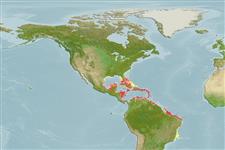Neopetrosia proxima (Duchassaing & Michelotti, 1864)
| Native range | All suitable habitat | Point map | Year 2050 |

|
| This map was computer-generated and has not yet been reviewed. |
| Neopetrosia proxima AquaMaps Data sources: GBIF OBIS |
Upload your photos
Google image |
No photo available for this species.No drawings available for Petrosiidae.
Google image |
No photo available for this species.
Classification / Names Common names | Synonyms | CoL | ITIS | WoRMS
Demospongiae | Haplosclerida | Petrosiidae
Environment: milieu / climate zone / depth range / distribution range Ecology
Sessile; brackish; depth range 53 - 60 m (Ref. 128739). Subtropical
Distribution Countries | FAO areas | Ecosystems | Occurrences | Introductions
Western Atlantic.
Length at first maturity / Size / Weight / Age
Maturity: Lm ? range ? - ? cm Max length : 4.0 cm OT male/unsexed; (Ref. 415)
Short description Morphology
Thick crusts: 1 - 4 cm in thickness, or sprawling masses with lobes. Color red-brown to pink externally and tan to yellowish internally. Oscules: 0.3 - 1 cm in diameter. Smooth surface, sometimes with zoanthids. Hard and fragile in consistency (Ref. 415). Porous surface, rugged with narrow conical to flattened protuberances. Dark greenish brown exteriorly, cream interior. Adhesive mucus exudate when animal is cut and touched. Flush oscules slightly elevated (Ref. 85482).
Maximum body thickness: 4 cm (Ref. 415). Common on sand and hard bottoms (Ref. 85482) of reef environments, coral rubble and seagrass beds (Ref. 415). Also found in mangroves (Ref. 86836). It hosts alpheid shrimps in its canals (Ref. 86626). Inhabits shallow rocky shores and reefs, deep reef habitats, caves, coralline algae reefs, and silted lower mesophotic reefs (Ref. 128739).
Life cycle and mating behavior Maturity | Reproduction | Spawning | Eggs | Fecundity | Larvae
Members of the class Demospongiae are hermaphroditic. Life cycle: The zygote develops into parenchymella larva (free-swimming) before settling down on a substrate where it grows into a young sponge.
Main reference
References | Coordinator | Collaborators
Collin, R., M.C. Díaz, J. Norenburg, R.M. Rocha, J.A. Sánchez, M. Schulze, A. Schwartz and A. Valdés. 2005. (Ref. 415)
IUCN Red List Status (Ref. 130435)
CITES status (Ref. 108899)
Not Evaluated
CMS (Ref. 116361)
Not Evaluated
Threat to humans
Harmless
Human uses
| FishSource |
Tools
More information
Internet sources
BHL | BOLD Systems | CISTI | DiscoverLife | FAO(Publication : search) | Fishipedia | GenBank (genome, nucleotide) | GloBI | Gomexsi | Google Books | Google Scholar | Google | PubMed | Tree of Life | Wikipedia (Go, Search) | Zoological Record
Estimates based on models
Price category
(Ref. 80766):
Unknown.


